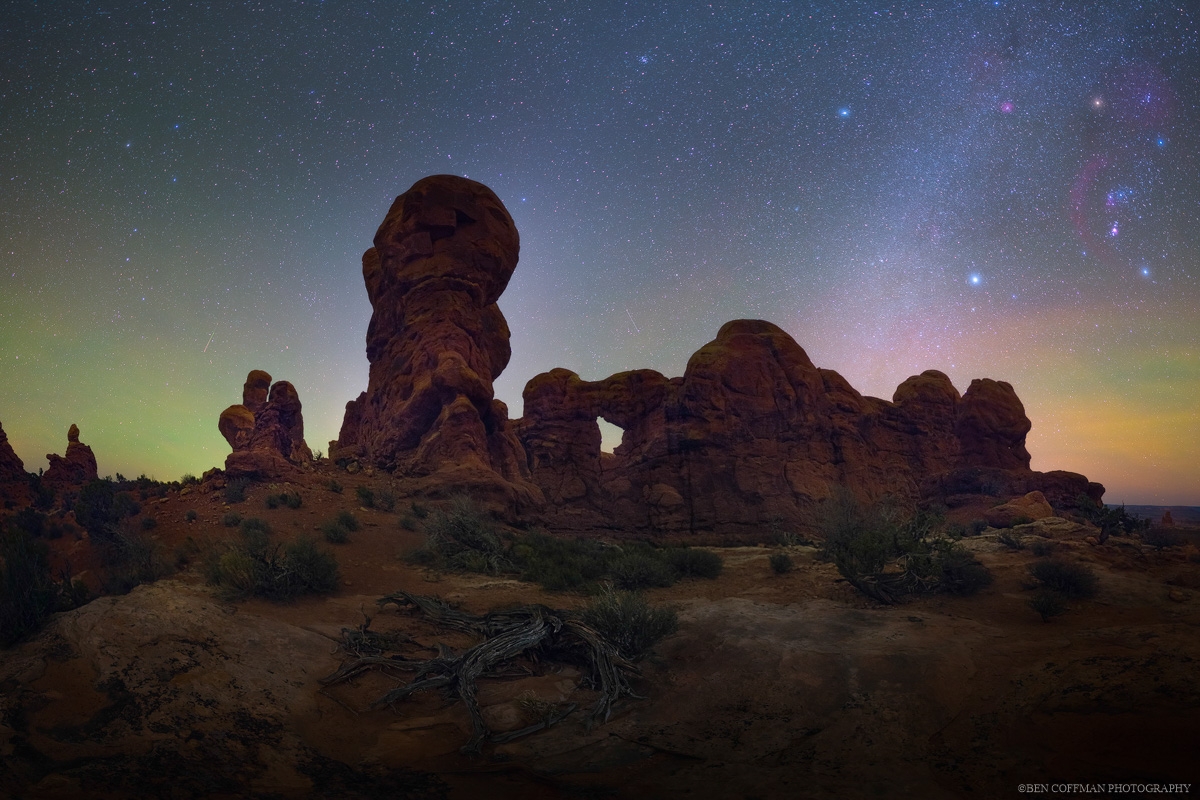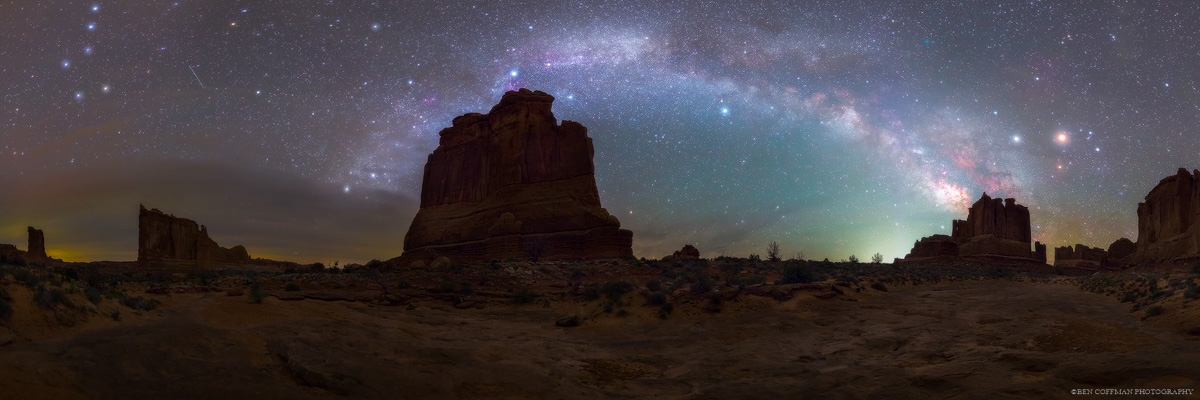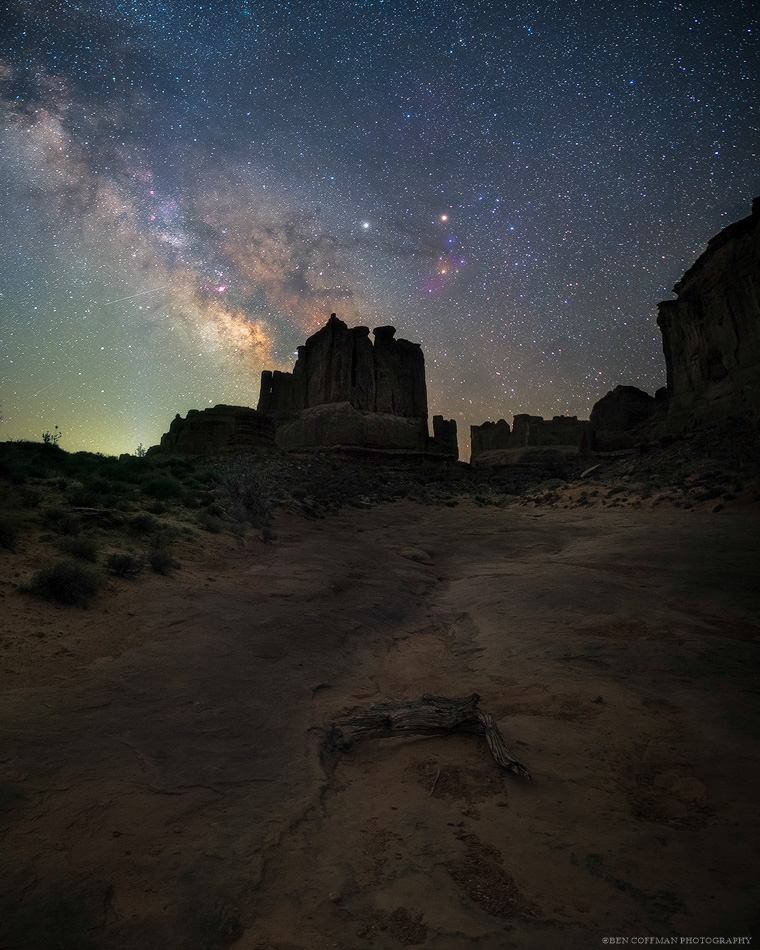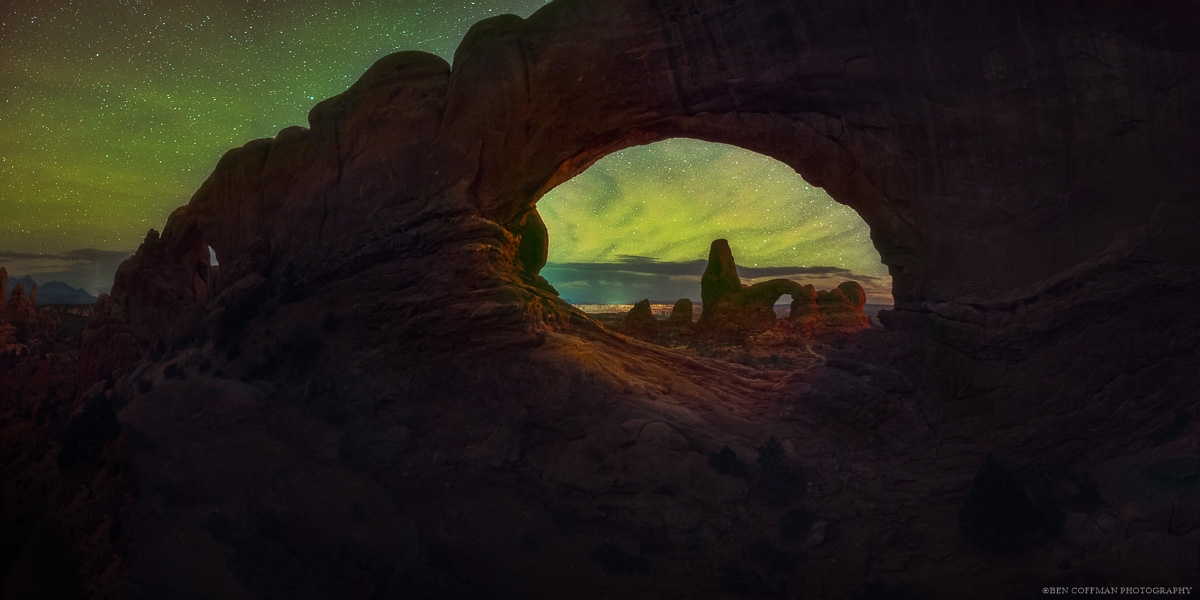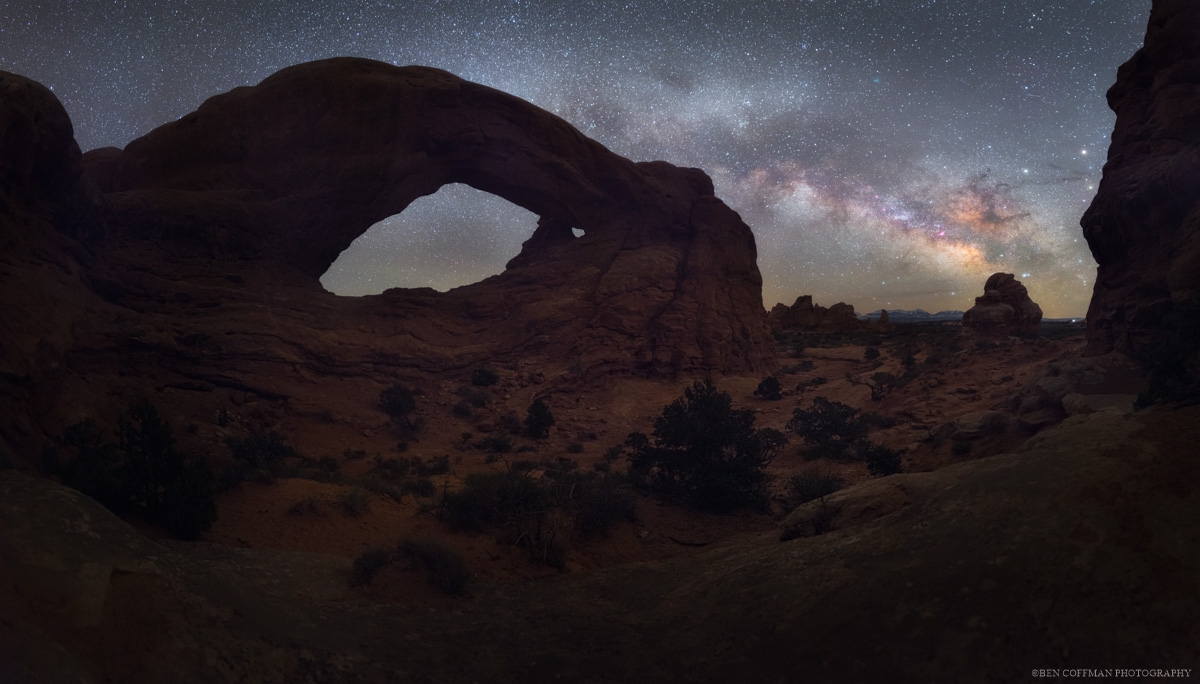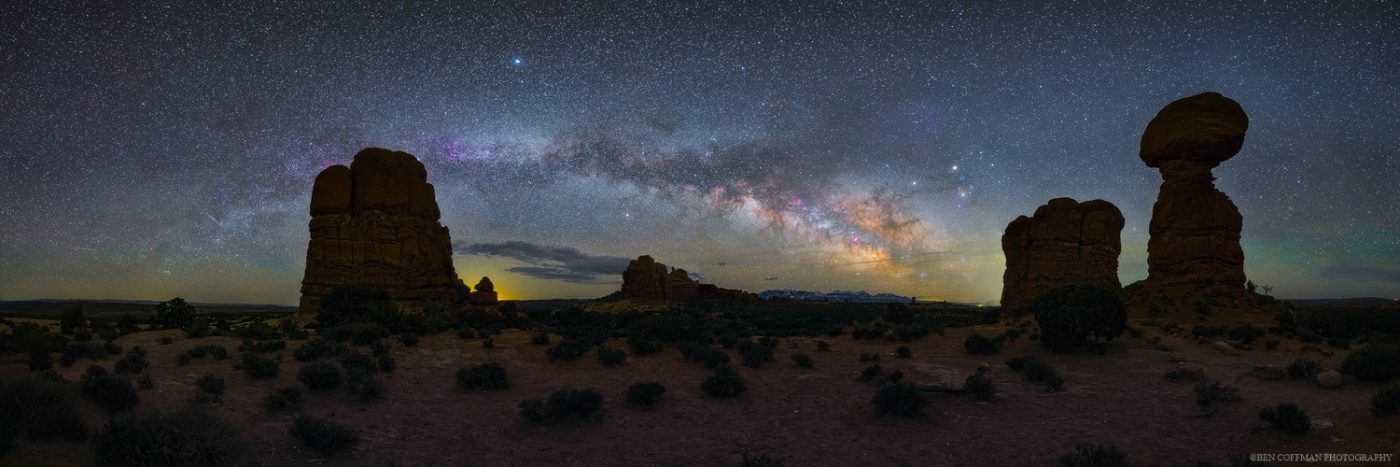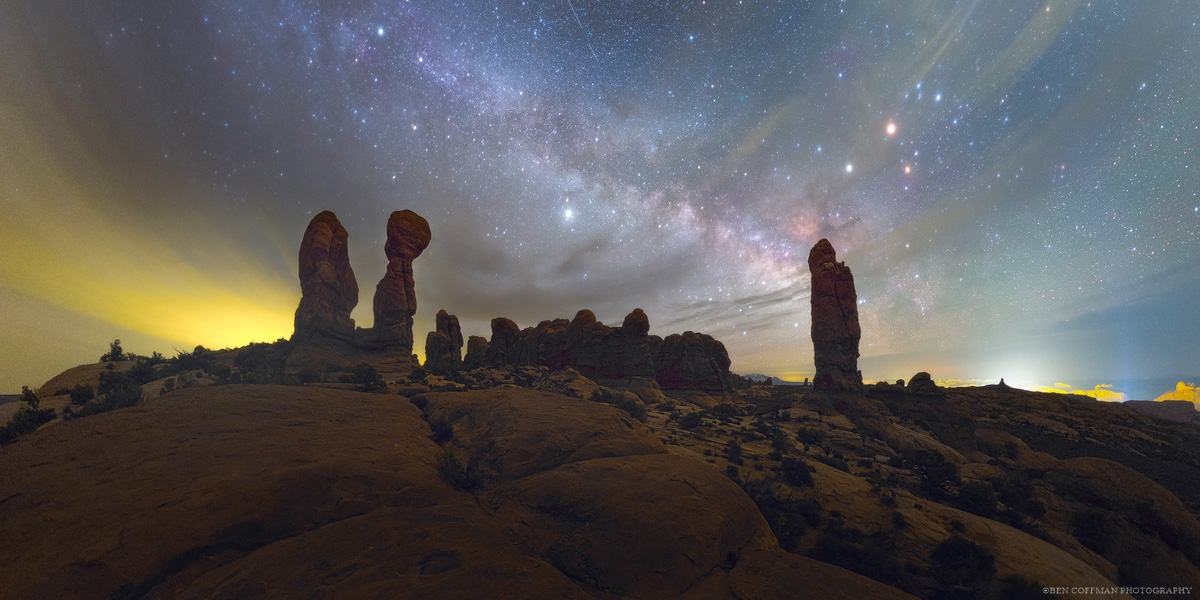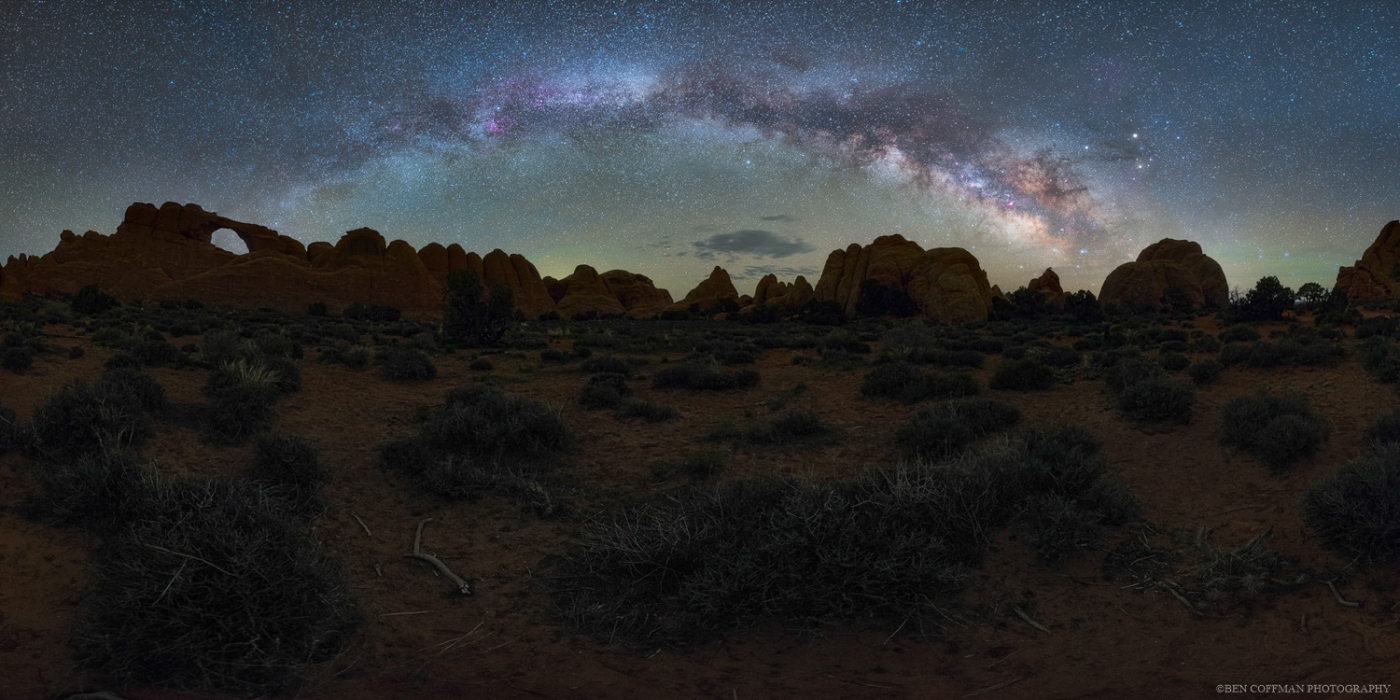*Thanks for your interest in my night photography workshops! Pending additional information regarding covid-19, I have not yet announced my 2021 workshop/lessons offerings. If you’re interesting in learning from me remotely or in hearing about workshops/lessons when they’re offered, please consider contacting me using the “Contact me” form below, or sign up for my newsletter on my main lessons page.*
I’m bringing my only panorama-intensive workshop back to Arches and Canyonlands National Parks, where we’ll explore magnificent arches, seek out great light, and capture the wonder of the night sky, all in a sweeping panorama format that shows off the grandeur of the park’s natural wonders and the vastness of its giant skies. As a bonus, with early sunset times we’ll be able to get in hours of night photography and still get a decent night’s rest.
OverviewWith the recent additions of better panorama-stitching algorithms in Adobe products like Lightroom and Photoshop, panorama photography is more accessible than ever before. Spend a couple of days and nights with me, fine-tuning your in-field panorama capture techniques to give you the best chance of stitching together flawless, high-quality panoramas, including the Milky Way’s arch. Although the Milky Way’s galactic center won’t be visible, late fall is a great time to avoid the crowds at Arches and Canyonlands and capture Southern Taurid meteors and Leonid meteors, the rising planets of Jupiter and Venus in near conjunction, a crescent moon over a lunar-like landscape, and moonless starry skies, all in one workshop.
Schedule
The workshop will begin on the afternoon of Friday, November 10th in Moab, with a 3-hour session at the Moab Arts and Recreation Center (MARC) from 1pm to 4pm in which we’ll test our equipment, cover the fundamentals of panorama capture, and go over composition as it relates to panoramas. Additionally, astrophotographer/landscape astrophotographer Jeff Lovelace will be giving a short presentation on the objects we’ll see and photograph in the night sky, titled “The Photographer’s Guide to the Galaxy.” That evening we’ll meet in either Arches or Canyonlands for a sunset and night shoot.
On Saturday, November 11th from 12pm to 4pm we’ll re-convene at the MARC for a “stitching session,” where we’ll stitch the previous day/night’s panoramas to prepare them for the long post processing session the following day. My software of choice for this is PTGui Pro, but Photoshop and Lightroom both have panorama-stitching functionality. There are also other free options, such as Hugin and Microsoft ICE.
That evening, we’ll meet in either Arches or Canyonlands for another in-field session.
On Sunday, November 12th we’ll meet at the Hampton Inn (488 N Main St) in Moab from 8:30 am until 5 pm for a post-processing session with Lightroom and Photoshop CC that will be capped off with some light critiquing.
Workshop goal
This workshop is intended for advanced beginner photographers who want to expand their knowledge of all types of panorama photography, including 360×180 virtual reality panoramas.
Number of openings: WORKSHOP FULL; Please use the “Contact me” form to contact me about being placed on a waitlist.
Experience level:
Cost: $500. I accept credit cards, debit cards, and Paypal. Payment can be made below.
A $200 nonrefundable deposit reserves your spot. Final payment is due 60 days in advance of the workshop or your space is not guaranteed. Cancellation must be made 60 days prior to the workshop date to receive a refund (minus deposit). If cancellation is made less than 60 days prior to the workshop date no refund (minus deposit) is given unless the spot can be filled. Note that prior to participating in my workshop I do require my participants to sign a liability release that will be delivered electronically.
What’s included:
- My ebook “2017 Gear Guide” (pdf)
- My ebook “Planning the Shot” (pdf)
- My workshop syllabus (pdf)
- Both classroom sessions and all in-field instruction
- My four new post-processing videos, totaling almost 1.5 hours of post-processing instruction in Lightroom and Photoshop CC (mp4)


BASIC RAW PROCESSING FOR MILKY WAY PHOTOGRAPHY – 19:23

Performing your first RAW edits may not be sexy,
but they’re most important edits you can make to
your photo. In this tutorial, I cover my beginning
workflow for high-ISO Milky Way photos, including
my RAW processing goals, adjustments to avoid in
RAW processing, reading your photo’s histogram as it
relates to night-sky photography, and achieving sharp
and low-noise photos.
STITCHING MULTI-ROW MILKY WAY PANORAMAS IN LIGHTROOM – 15:13

Recent updates have made Lightroom a formidable panorama
-assembly tool. In this tutorial, follow along while I go through
my Lightroom workflow for multi-row panoramas, including
preparing the RAW files for assembly in LR, using the
boundary warp tool, and putting the final touches on the assembly
in Photoshop.
STITCHING PANORAMAS IN PHOTOSHOP – 15:02

Sometimes Lightroom just can’t get the job done
when it comes to assembling panoramas. In this
tutorial, I show you my plan B: assembling the pano
in Photoshop. I also cover preparing the RAW files
as well as the use of guides and warping tools to
correct stitching errors.
POST-PROCESSING FOR TWILIGHT BLENDS – 31:02

Twilight’s a great time to shoot dramatic,
low-light photos with great color and low noise.
In this tutorial, I cover my basic twilight shooting
workflow, including RAW conversion, working with
twilight colors, and how to blend a sprinkling of
stars into your photo in Photoshop.
What’s not included:
Gear, lodging, transportation, national parks pass, food, and drink are not included in the price of the workshop.
FAQs
What kind of gear will I need for this workshop?
I recommend having a full-frame DSLR with live view as well as a wide (24mm or wider) and fast (f/2.8 or faster) lens. If you don’t already own these items, I would recommend renting them rather than buying them. A panorama head is my preferred method of creating panoramas, although nodal slides work well for single-row panoramas. You’ll also need a tripod and a wired or wireless remote. Additionally you’ll need appropriate (ie, warm) clothing and a good flashlight or head lamp. For the post-processing portion you’ll need a laptop with Lightroom and Photoshop (CC is preferred, but you’ll be able to follow along on older software). In addition to covering stitching in these programs, I’ll also be covering panorama creation in PTGui (my preferred software). My personal kit is covered extensively in my gear guide, which you’ll receive prior to the workshop.
Can I bring my friends/relatives/pets?
Unfortunately, I cannot accommodate non-paying participants or pets at my workshops. This has to do with permit limitations, the safety of other participants’ gear, and the integrity of other participants’ photographs. Adding extra flashlights can ruin photos, and extra legs (including animals’ legs) mean a higher risk of a tripod getting knocked over in the dark.
I’m a beginner photographer who just bought my first DSLR–is this workshop going to be too difficult for me?
This workshop is intended for intermediate beginners and up. During the introductory classroom session my goal is to streamline and simplify my students’ workflow so that they will spend a minimal amount of time switching settings while they’re in the field. However, as much as possible I like to provide my students with an understanding of why we do what we do because I believe it leads to a more comprehensive understanding of how to take good photos at night. If you’re a true beginner who has just started your photography journey, you may feel a little overloaded with information. One way to avoid information overload is to study basic photography terms and have a good understanding of your camera, its functions, and how to change your camera’s settings. As an example, if you don’t know what “stop down” means and have no idea how to do it on your camera, your opportunity to get the most out of this workshop may be compromised. The same is true of the post-processing portion: If your Lightroom isn’t properly set up to import files or your Photoshop workspace isn’t arranged so that, for example, the Layers palette is visible, you may find yourself using your time inefficiently. With that said, reading about photography, studying photography books available to the library, and familiarizing yourself with basic terminology can go a long way in moving a photographer from “true beginner” to “intermediate beginner” in a short amount of time.
Am I going to have to hike a lot on this workshop?
I encourage my workshop participants to have a reasonable base level of fitness, which includes an ability to walk slowly at night (with the aid of a flashlight or head lamp) up to a mile while carrying your own gear. If you have any questions or concerns about your fitness level, don’t hesitate to contact me (with the “Contact me” button below).
What about lodging?
The town of Moab is very close to Arches National Park and offers a variety of different types of lodging, including hotels, hostels, AirBnBs, and camping. Even though this workshop will be conducted during non-high season, I would advise you to arrange your lodging as soon as possible as other events may be taking place in Moab on the weekend of the workshop.
What airport should I fly into? Will I have to rent a car?
Salt Lake City has the nearest large airport to Arches National Park. If you’re flying, you will need to rent a car, as transportation for this workshop is not covered.
I can’t bring my camping gear if I fly. What should I do?
I would consider one of two options. A) You could pay the extra baggage fees and check your camping gear, including your tent. B) Moab has plenty of options for outdoor supplies, and you could probably buy or rent camping gear for less than the cost of checking your regular camping gear in your bags.
What if I drop my camera in the dark?
I encourage all of my students (and all photographers in general) to insure their equipment. Although I have a clean record thus far of my students remaining injury-free and their equipment being undamaged during my workshops and lessons, from my personal experience taking photos in low-light situations runs a higher risk of personal injury (tripping or losing your balance in the dark) and equipment damage (tripod falling over or getting knocked over).
When will I receive the pdfs and other pre-workshop instructionals so that I can begin studying on my own?
You will receive all pre-workshop instructionals at least 60 days in advance of the workshop, assuming you have paid in full.
What if the weather’s not conducive to night-sky photography?
Unfortunately, I cannot offer refunds for poor weather unless the weather conditions are outright dangerous, such as blizzards, tornadoes, or extreme lightning. I do recommend that my workshop participants allow some flexibility in their schedules so that last-minute changes (such as moving the workshop up a day or back a day) can be made to avoid dangerous weather. Otherwise, regardless of cloud cover, we’ll go ahead with our curriculum so that you’ll be armed with the knowledge you need to capture and post-process starry skies when the conditions are right.
I heard that night photography is no longer allowed in Arches or Canyonlands. What’s up with that?
As of the time of this writing, 2017 will be the last year that night photography workshops can legally be led in Arches and Canyonlands National Park. For 2017, teaching light painting in Arches and Canyonlands National Park is no longer allowed. (Note that this doesn’t mean that light painting is banned, but it does mean that as a workshop leader I cannot teach light painting as a part of my curriculum.) You’ll notice that light painting is featured in very few of my night-sky panoramas, and I prefer to do most of my panoramas by starlight.
